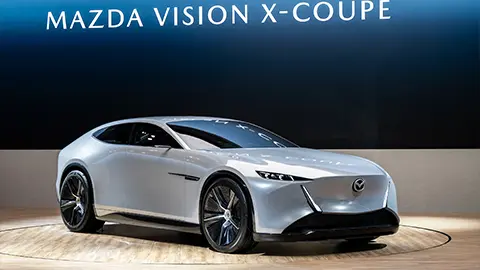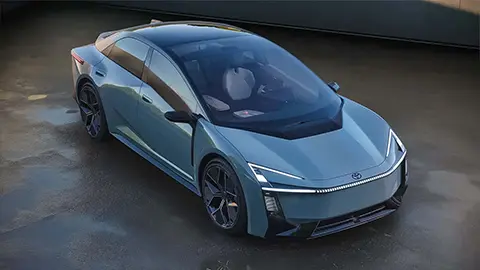Lexus: Hybrid Luxury Brand Is Going EV
Lexus, one of the pioneers in hybrid power, has been slow to embrace fully-electric powertrains. The brand’s first EV, the RZ crossover, only went on sale this year, and has so far been delivered only in small numbers. But at the recent Japan Mobility Show in Tokyo, the company previewed two new models that it says will “push the boundaries of the electrified experience.” The LF-ZC is a concept car that previews a next-generation EV set to debut in 2026, while the LF-ZL is a fully-electric flagship model that previews the brand’s future at the top of its range. The two models are part of Lexus’ stated commitment to becoming a fully-electric brand by 2035.

Lexus LF-ZC To Take On Tesla Model 3
Sized similar to the Tesla Model 3 and its Model Y crossover variant, the Lexus LF-ZC (Lexus Future Zero-emission Catalyst) previews next-generation Lexus electric cars, which will launch I 2026. With a drag coefficient of under 0.2, it will be extraordinarily slippery and efficient, which should contribute to exceptional range. Built using a dedicated EV platform, it will have much more versatile packaging than today’s RZ crossover, which shares some of its architecture with gasoline Lexus vehicles.
Not only will this make for a more spacious interior on a relatively compact footprint, but it should also translate to a great driving experience, with a low center of gravity, great handling, and immediate responses. Lexus says the LF-ZC will feature technology that first debuted on the RZ, including the all-wheel drive Direct4 EV drive system with dual motors, and electronic steer-by-wire technology.
Inside the sleek, angular exterior is a new, highly digital cockpit with an all-new “Arene OS” software platform that offers advanced safety and multimedia features. Drivers can adjust every aspect of the way the car performs, such as its acceleration and handling, through the intuitive interface. Powered by advanced AI, next-generation voice recognition lets drivers and passengers feel like they’re interacting with a concierge in the car, which responds to all of their needs. Not only can the concierge alter the climate control, find charging stations, and alter the car setup, but it can also provide route and mode recommendations based on the driver’s preferences and daily habits.
As befits an EV designed to be efficient and sustainable, the Lexus LF-ZC’s interior focuses on circular resource use and innovative materials. Bamboo sits alongside unique colors and materials to create a truly unique, but still luxurious, ambiance. Bamboo is known for fast growth, its ability to rapidly absorb CO2, and for its enduring beauty.

Lexus LF-ZL Previews an Electric Flagship
A little further off is a brand-new Lexus electric flagship model, which is previewed by the LF-ZL (Lexus Future Zero-emission Luxury) concept car. A more conceptual look at the future of Lexus, the LF-ZL takes advantage of an EV-specific platform to optimize the interior space and package, with a unique tall look and remarkably spacious cabin. It takes the new Arene OS’ AI capabilities even further into the future; Lexus says that the car will generate “fresh experiential value” by learning and anticipating the driver’s needs. The car can then interact with infrastructure and services outside the car to make the mobility experience easier and more personalized. For example, drivers will be able to point to objects or places of interest while in motion, and the car can deliver information about those places in real time. The use of AI and connected services also allows even better management of the charging process.
The LF-ZL concept car, befitting its flagship status, is a large vehicle, almost as long as the brand’s LS sedan. On the outside, the sleek silhouette starts with a very low-slung hood (there’s no more large engine that needs to be housed) that flows into prominent rear wheel flares and a tapered cabin. Passengers are seated low and forward, taking full advantage of the fully-EV platform, with a panoramic roof overhead to improve the feeling of spaciousness. There’s an expansive interactive screen in front that consolidates all important functions, and allows the vehicle to be updated constantly over its lifecycle.

Next-Generation EV Battery Technology
Both the Lexus LF-ZC and LF-ZL concept cars feature Toyota/Lexus’ next-generation prismatic high-performance battery technology. Lexus claims that these new batteries will achieve approximately twice the range of conventional electric cars, instantly alleviating range concerns and offering drivers long-distance cruising that can easily take them from city to city.
The batteries’ prismatic structure also allows engineers to be more clever in how they are integrated into the vehicle, improving overall efficiency and battery performance. Prismatic cells can be of a much lower profile, contributing to increased design flexibility, sleeker silhouettes, and ultimately better aerodynamics. They also allow for a more compact, dense battery structure, letting engineers cram more capacity into the vehicle without increasing weight and size.
Furthermore, Lexus’ next generation of electric cars will be built on a new, modular structure that uses “gigacasting” to manufacture the entire vehicle body in three large parts: front, center, and rear. This casting process, first pioneered by Tesla, increases rigidity, but also gives engineers more freedom with complex shapes to create innovative packaging solutions. The three large castings are built around the battery, which remains structurally independent – meaning advancements in battery technology can be easily integrated into future models with little cost or delay.
















